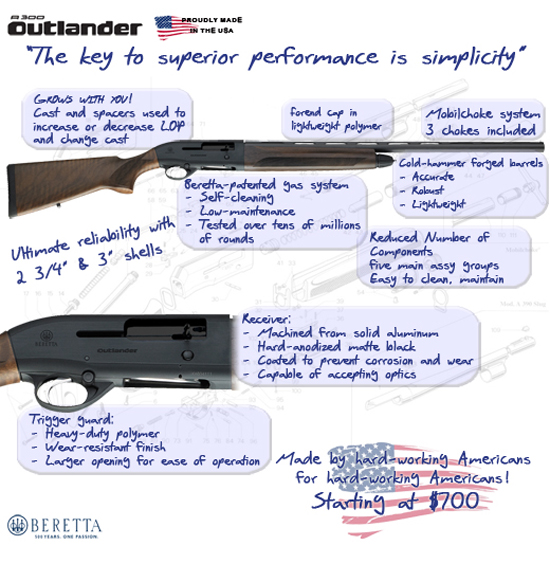Common Beretta A300 Outlander problems include cycling issues and occasional jamming. Some users also report difficulty with the bolt release.
The Beretta A300 Outlander stands as a versatile semi-automatic shotgun, acclaimed for its reliability and performance in various shooting environments. Designed with both hunting and sport shooting in mind, this firearm combines Beretta’s legacy of quality craftsmanship with modern technology.
Despite its many strengths, a handful of users have encountered problems, primarily related to its cycling mechanism and bolt operation. These issues, while not widespread, can affect the shotgun’s overall performance and user experience. As with any firearm, regular maintenance and proper handling can mitigate most of these concerns, ensuring the A300 Outlander lives up to its reputation for excellence.

Credit: gunfixsolutions.com
Introduction To The Beretta A300 Outlander
The Beretta A300 Outlander is a versatile shotgun. It blends reliability and performance. This firearm caters to hunters and sport shooters.
Popularity And Usage
The A300 Outlander’s popularity stems from its user-friendly design. It’s known for consistent shooting in various conditions. Its wide adoption reflects its quality.
- Hunting: Preferred for its accuracy.
- Sporting: Used in competitive shooting.
- Recreational: Loved for its ease of use.
Purpose Of This Article
This article addresses common issues faced by A300 owners. It provides troubleshooting tips and maintenance advice. The goal is to ensure optimal performance.
Common Issues Faced By Users
The Beretta A300 Outlander is a popular shotgun. It is known for reliability. Yet, some users report problems. This section explores common issues.
Cycling Failures
The A300 Outlander might fail to cycle shells. This can happen with various ammo types. Here’s a list of potential causes:
- Dirty Action: Residue impedes movement.
- Weak Ammo: Insufficient power to cycle.
- Worn Components: Parts need replacement.
Regular maintenance can prevent such issues. It’s important to clean and lubricate the action. Always check ammo compatibility.
Ejection Inconsistencies
Ejection problems can be frustrating. They can disrupt shooting experiences. Here are common causes:
| Issue | Possible Cause |
|---|---|
| Stovepipe Jams | Obstructed ejection port |
| Partial Ejection | Worn extractor or spring |
| No Ejection | Broken ejector mechanism |
Inspect and clean the ejection port regularly. Replace worn parts as needed. This ensures smooth ejection during use.
Troubleshooting Feed Problems
Many shooters love the Beretta A300 Outlander for its reliability and performance. Yet, some users face feed problems. This section will guide you through troubleshooting feed issues efficiently.
Inspecting The Magazine
First, check the magazine. Dirt or damage can cause feed problems. Follow these steps:
- Ensure the gun is unloaded.
- Remove the magazine and inspect for visible damage.
- Look for any obstructions that might block the path of shells.
- Check the magazine spring and follower for wear and tear.
Replace any damaged parts immediately. Regular inspection helps prevent feed issues.
Proper Cleaning Techniques
Correct cleaning is crucial for a smooth operation. Dirt affects the A300 Outlander’s performance. Here’s how to clean it properly:
- Disassemble the shotgun according to the manual.
- Use a quality gun cleaner to remove fouling from the barrel and action.
- Clean the gas ports thoroughly to ensure proper gas flow.
- Lubricate moving parts lightly with gun oil.
Cleaning after each use maintains the gun’s reliability. Remember, a clean gun is a happy gun.
Ejection Issues And Fixes
Ejection issues can frustrate any shooter. The Beretta A300 Outlander is not immune. These problems often stem from two main parts: the extractor and the ejector. Proper maintenance and timely adjustments can fix these issues. Let’s dive into common ejection problems and their solutions for the A300 Outlander.
Examining Extractor Health
The extractor is key for reliable ejection. Signs of wear or damage mean it’s time for a check-up. Look for these signs:
- Weak ejection: The shell doesn’t clear the ejection port.
- Failure to eject: The shell stays in the chamber after firing.
- Visible damage: Cracks or chips on the extractor’s claw.
Replace a worn extractor with a new one. Clean the extractor groove regularly. Use a brush and solvent to remove dirt and debris.
Adjusting The Ejector
Proper ejector function is vital for smooth ejection. Follow these steps to adjust:
- Ensure gun safety: Check that the firearm is unloaded.
- Disassemble: Take apart the firearm according to the manual.
- Inspect: Look for signs of wear or damage on the ejector.
- Clean: Wipe down the ejector and its spring with a cloth.
- Adjust: Bend the ejector slightly if it’s not making proper contact.
- Test: Reassemble and test the gun to ensure correct ejection.
Consult a professional if problems persist. Regular maintenance prevents future issues.
Maintenance Tips For Longevity
Keeping your Beretta A300 Outlander in top shape is vital. Proper maintenance ensures reliability and longevity. Simple steps can prevent common problems. Let’s dive into the essentials of upkeep.
Regular Cleaning
Clean your shotgun after every use. This prevents buildup. Dirt and residue can cause malfunctions.
- Disassemble the shotgun as the manual instructs.
- Use a cleaning kit. It should have brushes, solvent, and lubricant.
- Wipe down all parts. Pay attention to the barrel and action.
- Apply lubricant sparingly. Too much attracts dirt.
Regular cleaning keeps the A300 Outlander running smoothly.
Periodic Parts Replacement
Some parts wear out with time. They need replacement to avoid failure.
- Inspect springs and pins regularly. They can wear or break.
- Check the gas system for signs of stress.
- Replace the O-rings annually. They ensure a proper gas seal.
Follow these tips for a dependable shotgun. Your A300 Outlander will reward you with years of service.

Credit: theshotgunguide.blogspot.com
Upgrades To Enhance Performance
Owners of the Beretta A300 Outlander often seek improvements. These upgrades boost the shotgun’s performance. Let’s explore options to make the A300 Outlander better.
Aftermarket Parts
Aftermarket parts play a key role in enhancing performance. They offer precision and reliability. Here are top picks:
- Trigger kits: Improve response and feel.
- Barrels: Offer better accuracy and range.
- Stocks: Enhance grip and stability.
Improving The Gas System
The gas system is crucial for a smooth operation. An upgraded system reduces recoil and improves cycling. Consider these steps:
- Clean the gas ports regularly.
- Use high-quality gas pistons.
- Check seals and replace if worn out.
These upgrades make the A300 Outlander more reliable and enjoyable to use.
User Experiences And Reviews
User experiences and reviews are vital for understanding the Beretta A300 Outlander. They provide real-world insights. Let’s explore what users say about this shotgun.
Positive Feedback
- Reliable performance in various conditions.
- Easy to clean and maintain.
- Accurate shooting praised by many.
- Users love its comfortable handling.
- Many find it great value for money.
Critical Perspectives
- Some report stiffness in the action.
- A few users faced jamming issues initially.
- Weight distribution could be better.
- Occasional factory defects noted.
- Limited customization options for some users.
Expert Opinions On Reliability
When exploring the Beretta A300 Outlander, reliability is a key factor. Users and experts often share their experiences. These insights are crucial for potential owners.
Gunsmith Insights
Professional gunsmiths handle many firearms. They know each gun’s strengths and weaknesses. Gunsmiths give valuable feedback on the A300 Outlander. They often praise its solid build and dependable action. Yet, some note occasional issues with cycling. They stress regular maintenance for peak performance. This includes proper cleaning and using recommended ammunition.
Comparative Analysis With Competitors
When compared to its rivals, the A300 Outlander stands out. Experts note its affordability and ease of use. They also highlight the Outlander’s versatility in various shooting conditions. The A300’s gas-operated system is smooth. This system reduces recoil and improves shot recovery. Competing models may offer different features. Yet, the A300’s balance of cost and function remains attractive.
| Feature | A300 Outlander | Competitors |
|---|---|---|
| Price | More affordable | Varies |
| Reliability | High with maintenance | Depends on model |
| Recoil | Less recoil | More recoil |
Conclusion And Final Thoughts
Wrapping up our discussion on the Beretta A300 Outlander, it’s evident that while this shotgun excels in many aspects, it isn’t without its flaws. Addressing these issues promptly ensures reliable performance and longevity for shooting enthusiasts.
The Beretta A300 Outlander is a staple among hunting enthusiasts. Despite some issues, its reliability stands out. Let’s recap solutions and assess the shotgun’s overall performance.
Recap Of Solutions
- Cleaning: Regular maintenance prevents most problems.
- Manual: The user guide solves user-related errors.
- Parts Replacement: Use genuine parts for longevity.
- Expert Advice: Professionals troubleshoot uncommon issues.
Overall Assessment Of The A300 Outlander
The A300 Outlander excels in design and function. Its issues are fixable. With proper care, it provides an unmatched shooting experience. Its value and dependability make it a top choice for shooters worldwide.

Credit: www.reddit.com
Frequently Asked Questions
What Are Common Beretta A300 Issues?
Beretta A300 Outlander users sometimes report jamming, stiff controls, and ejection failures. Regular maintenance can mitigate these issues.
How To Troubleshoot Beretta A300 Malfunctions?
Clearing debris, ensuring proper ammunition use, and checking the gas system can help resolve most Beretta A300 malfunctions effectively.
Can Weather Affect Beretta A300 Performance?
Extreme weather conditions can impact the Beretta A300’s performance, including its cycling speed and reliability.
What Is The Beretta A300’s Lifespan?
With proper care and maintenance, the Beretta A300 Outlander can last for many years, often surpassing a decade of reliable service.
Are There Any Recalls For Beretta A300?
As of the knowledge cutoff date, there have been no widespread recalls for the Beretta A300 Outlander shotgun.
Conclusion
Navigating the quirks of the Beretta A300 Outlander is essential for shooting enthusiasts. This post has aimed to highlight common issues and their fixes. Armed with this knowledge, owners can enjoy the reliability and performance that the A300 Outlander is renowned for.
Remember, regular maintenance is key to a smooth experience. Happy shooting!